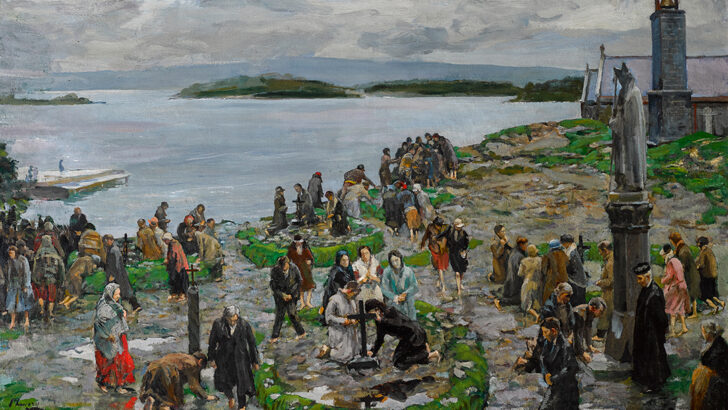An exhibition at the National Gallery of Ireland,
curated by Prof. Kenneth McConkey and Dr Brendan Rooney
7 October 2023-14 January 2024, Rooms 6-10, Beit Wing | Ticketed
Email: exhibitiondesk@ngi.ie or phone: (01) 663 3513
Lavery on Location,
a companion book to the exhibition by Professor Kenneth McConkey with an essay by Dr Brendan Rooney
(National Gallery of Ireland, €45 /£40.00)
Sir John Lavery is the sort of painter that people think they have a very clear and exact impression of, based largely on his early society portraits and the many important pieces he produced during Ireland’s revolutionary period, which ended with an image of his wife leaning on a harp gracing the new currency notes of the emergent Irish state.
But this wonderful exhibition shows how limited this idea of Lavery is when one sees, as here, the fullest range of what he created over the course of his career.
The range of topics and treatments is very varied and the show displays many items borrowed from private collections that widen and deepen everything that we thought we knew. This is quite emphatically the ‘must-see’ show of the autumn.
It has been organised in partnership with the National Museum of Northern Ireland and the National Museum of Scotland. This has allowed a generous selection of Lavery’s work over the whole length of his long career to be assembled in one place for the first time.
Lavery, it will be recalled, was born in Belfast in 1886. He studied in Paris, established his career in Glasgow and finally settled in London. He died in Co. Kilkenny in January 1941, but is buried back in London in Putney.
Reflected
This highly mobile, full life is well reflected in the pieces on display. But special attention is given to places he visited in the later decades of his life, France, Morocco, and the American West coast.
Many items on show run counter to what one thinks of as Lavery’s usual manner. These are both large and small. I found very human a small portrait from his early days in Glasgow, of Daniel Santiagoe, author of the then best-selling book The Curry Cook’s Assistant – clearly of Portuguese extraction from Kerala. He makes a charming contrast to all those society ladies!
Also charming is the little scene of two small children giving a fright to a gaggle of geese, probably in France. It makes a contrast to his usual treatment of locations in and around Grez-sur-Loing.
So many of Lavery’s pieces depend on his exploitation of colour, as in the North African scenes and the western American one. So much so that what is perhaps the most unusual picture in the show, ‘Central Park from The Plaza, New York’ (1926) is a stark contrast. In this his palate, usually so lush, is muted to sombre shades of grey, brown, and a dull light green. One feels the chill of autumn in the ultra-modern, high rise city looking at it.
Also of great interest are his paintings of Morocco and Tangier – at the time an International Zone, described by one writer as “the last free place on earth”, and by another as a place that “feeds on the flesh of strangers”, with a rather louche population of very dubious repute.
But what Lavery liked in these North African regions was a different kind of freedom, focused on the Berbers and Arabs.
Making quite a contrast to the scenes of international life is ‘St Patrick’s Purgatory’ (1929), which Lavery, having consulted with Sir Shane Leslie, a convert, and with the permission of the Prior, painted over a period of three or four days the studies on which the finished work is based. The Scotsman admired it as showing what he could do when he abandoned society life.
It was picked out by Yeats in one of his late, great poems as a sort of icon of Irish life, but Lavery who had been hoping for Western country people in traditional dress was disappointed that the pilgrims he saw were “city types from Belfast and Dublin” dressed in ordinary clothes. It is, however, a most moving picture, and makes a refreshing contrast to Keating’s scene of Western pilgrims, which is a mere travesty.
Society
But the picture that gives one the most food for thought is ‘Monte Carlo, Afternoon’ (1929), which captures the scene of day time society gamblers in the private rooms of the Casino. This was a sad scene, even to Lavery, who wrote of “the beau monde… grimly and anxiously employed” losing money.
This was a year of gambling fever on the world’s stock exchanges ending in the debacle of ‘The Great Crash’ in the last days of October, which provided new definitions of employment and gambling.
So, though he might easily be seen as a recorder of scenes from that beau monde, Lavery’s accurate eye and acute sense of humanity made him also a recorder of historic scenes throughout his whole career. As I say, a must see show of the first order.


 Peter Costello
Peter Costello Sir John Lavery (1856-1941), St Patrick’s Purgatory, 1930. Collection and image © Hugh Lane Gallery, Dublin.
Sir John Lavery (1856-1941), St Patrick’s Purgatory, 1930. Collection and image © Hugh Lane Gallery, Dublin. 